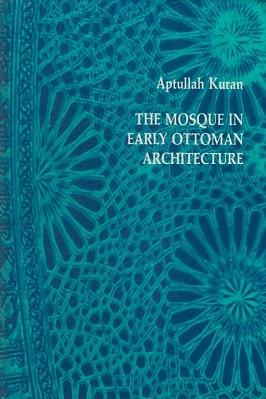
| The Mosque In Early Ottoman Architecture |
| Aptullah Kuran |
| 246 |
| |
| PDF Direct Download Link |
| Click for Hard Copy from Amazon |
The Mosque in Early Ottoman Architecture by Aptullah Kuran
THE MOSQUE IN EARLY OTTOMAN ARCHITECTURE
Book’s Preface
This book is the first part of a proposed trilogy on Ottoman mosque architecture . It deals with what I consider to be the most significant Ottoman mosques of the fourteenth and the fifteenth centuries.
The second and third books will take up the Golden Age (sixteenth and seventeenth centuries) and the Decline (from the early eighteenth century to the end of the World War I), respectively.
I began studying Ottoman mosques in 1961. Three years later my first book on early Ottoman mosque architecture was published in Turkish.
The present book, however, is not a translation of the earlier work; it includes a great deal of new material-some of it heretofore neither published nor widely known-as well as a number of alterations and corrections.
At the start of this undertaking I decided to see, measure, and photograph as many mosques as possible and not to include in my book any that I had not actually seen and studied on location.
I have not been to the Balkan countries and am familiar with Ottoman architecture in these countries only through scholarly works.
For this reason, with the exception of one mosque in Dimetoka, Greece, which had to be included because of its unique place in the evolution of Ottoman mosque architecture, all examples in this book have been taken from within the boundaries of modern Turkey.
Whenever possible they have all been especially photographed for it and, even when measured drawings existed, were remeasured for accuracy and newly drawn ..
Book contents
- Introduction
- The “Single-Unit” Mosque
- Single-Unit Mosque with Complex Massing Single-Unit Mosque with Articulated Interior
- The Eyvan Mosque
- Axial Eyvan Mosque
- Cross- A xial Eyvan Mosque
- The “Multi-Unit” Mosque
- Multi-Unit Mosque with Similar Units Multi-Unit Mosque with Dissimilar Units
- Analysis and Conclusion Notes
- Glossary
- Chronological List of Early Ottoman Mosques Bibliography
- Index
Book introduction
Comparatively little attention has been given to date to the architecture of the Ottoman Turks despite the fact that, as they evolved from a small community to one of the biggest and longest-lasting empires the world has ever known, they left behind them a rich architecture.
The Ottoman Turks were great builders, engaging in extensive building activity as early as the first half of the fourteenth century.
Initially in their first capital city of Bursa, then in Edirne and Istanbul, the principles of Ottoman Turkish state architecture were developed, formulated, and disseminated.
Monumental or modest examples of their architecture remain today wherever Ottoman Turks have been.
No civilization that comes in contact with other civilizations can claim immunity from outside influences.
The Ottoman Turks were no exception. It would be unrealistic to assume that a tribe of Turkish people who migrated from central Asia to western Anatolia, building an empire that stretched from Istanbul to Iran, Yemen, Egypt, Algiers, Hungary, and the Crimea were not interested in, or influenced by, historic or contemporary works of art and architecture which they encountered and that these influences did not play a part in the formulation of Ottoman Turkish state architecture.
It would be equally unrealistic to suppose, however, that superior building techniques, limitless financial means, and the desire for grandeur could in themselves be sufficient to attain architectural excellence and that significant works of art could be produced outside a cultural ambient that kindles the imagination of the artist and the architect.
It would be too easy to draw quick parallels between the monumental mosques of Istanbul and the Hagia Sophia, or to dismiss Ottoman Turkish works as the anticlimax of Byzantine architecture.
The influences of Byzantine or Seljuk works on Ottoman Turkish architecture can easily be detected. This is only natural because architecture is a continuum.
One cannot think of Gothic architecture without the preceding Romanesque, or the Renaissance without
the Roma n. The question is not so much what each era took from an earlier period but what it has been able to do with what it found and whether what it left behind is significant.
Ottoman Turkish architecture of the sixteenth century can stand comparison with any great style of architecture of its day and Suleyman the Magnificent’s chief architect Sinan (1490-1588), can easily compete with any Renaissance architect of the fifteenth or sixteenth centuries.
The purpose of this book, however, is not to discuss the golden age of Ottoman architecture, or the architect Sinan, but to study the nature and the evolution of only one type of Ottoman Turkish building- that of the mosque during the first two centuries of the Ottoman Empire.
The book covers the period from the early thirteenth century to 1506, when the Mosque of Bayezid II in Istanbul, generally considered to be the first of the monumental Ottoman mosques, was inaugurated.
In other words, it will not primarily be concerned with the masterpieces of Ottoman Turkish architecture, but with those modest and experimental buildings which must precede the peak and prepare the groundwork for it.
To read more about the The Mosque In Early Ottoman Architecture book Click the download button below to get it for free
or
Report broken link
Support this Website
for websites